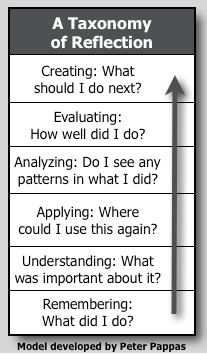Like all other aspects of teaching, the use of reflection as a teaching practice – be it the teacher’s or the student’s – is rooted in theory and has become more innovative over time. Teachers are coming up with more and more creative ways for reflective practice to occur. The reasons for reflection are varied, and there is a vast assortment of reflections available, depending on the purpose and the age of the reflectors. Consider the following questions:
Who is doing the reflecting? Students or teacher? Individuals? A group? The whole class?
What type of reflection will you use? Will it be verbal, paper or digital? What kind of format will it be? Will you use a particular theoretical model, such as Dewey’s 5-Step Model, de Bono’s Six Thinking Hats, or Pappas’ A Taxonomy of Reflection?
Where will it happen? Will it be on paper, using a specific format? Will it be on a digital platform, as part of a portfolio? (Seesaw is a great app for online portfolios.) Or, think physical space — Will it be in the classroom? On a field trip? In the library? Outside, in a more open space?
When will it happen? Will it happen before, during, or after a task? Will it happen before, during, AND after a task? What time of day will it happen, and how much time will be allotted for it? Will it be a one-time reflection, or will it happen regularly?
What’s the purpose for the reflection? Is it to sort out thoughts about a task? Is it to contemplate how a skill or behaviour could be improved? Is it to work out a solution to a problem? Is it to help improve a lesson or unit for next time?
How will it be presented as a method of learning? Will the teacher model self-reflection or use scaffolding? How will it be presented so that it is authentic and not forced?
Below, I’ve included a link to some posters with student self-reflection prompts. You can use them as verbal reflections, or you can have students write their responses in a journal, perhaps. I’ve also included links to some (free) oral and written reflection activities and templates that I found on the Teachers Pay Teachers website. Have a look, and see if there are some you already use, or would like to try. Remember, there is no one way to use reflection. Use whatever works best for you and your students. Use them individually, or try group or whole class reflections. Some are meant for younger students, some are for older students. Some are more open-ended, while others are more fixed in their design.
One more thing to note: always remind students that their reflections might only be a snapshot in time. They’re not meant to be limiting or conclusive. Remind them (and yourself) that reflections are just a way to help us become better learners. Make it fun and interesting. Maybe you can do your own as they are doing theirs! Help students to become comfortable with their reflections, and yourself as well. When we’re calm and relaxed, that’s often when ‘real’ learning happens and ideas start to flow. Let the reflections inspire Teacher and Learner creativity! Enjoy the process.
Learning Behaviours Self-Reflection
Service Learning Journal and Reflection
End-of-the-Day/Week Reflection Cards
End-of-the-Day Reflection Cards
End-of-the-Day Reflection Sticks
Formative Assessment and Activity Reflection
My Self-Reflection Report Card
Student-Led Conference Organizer
Happy reflecting!
References:
FreshGrade. (2017, February 03). Prompts for Student Self-Reflection [POSTERS]. Retrieved August 7, 2018, from https://www.freshgrade.com/blog/prompts-for-self-reflection/.
Teaching Resources & Lesson Plans. (n.d.). Retrieved August 12, 2018, from https://www.teacherspayteachers.com/.

